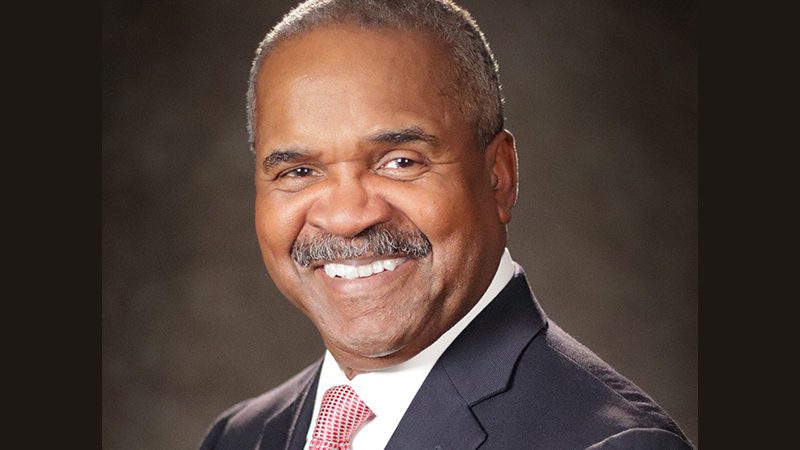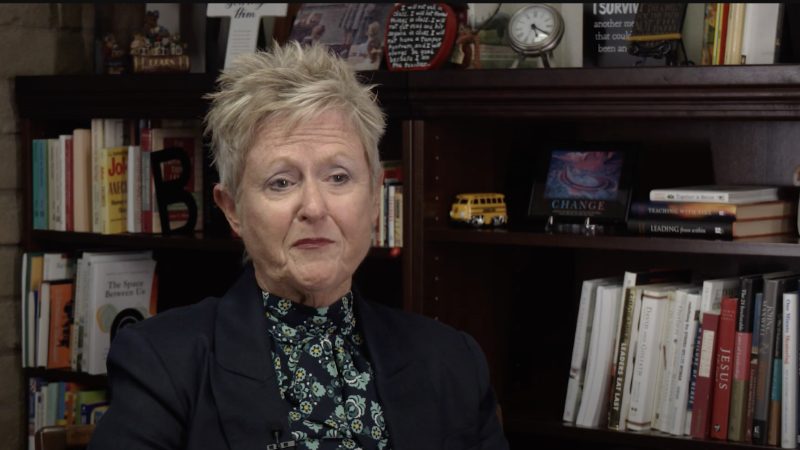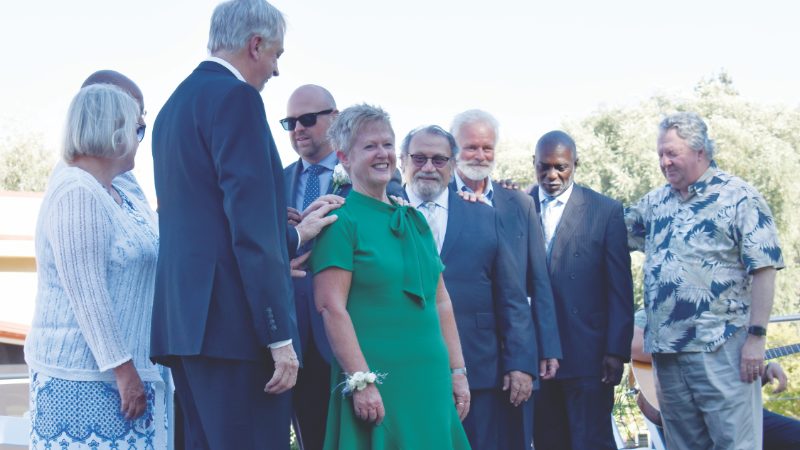The Educational Leadership Council recently experienced an exciting and realistic training simulation at the Reagan Library in Simi Valley, California.
Ed Leadership is made up of the staff of the Pacific Union Office of Education, conference superintendents and associate superintendents, and representatives of academic leadership. Members meet three times each year to discuss issues facing Adventist education, to collaborate on initiatives that will benefit students, and to expand the leadership skills of school leaders.
The training simulation is designed to highlight communication, decision-making, critical thinking, and crisis management skills. The participants assumed roles of the White House crisis management team, members of the intelligence community, and the media—all facing multiple challenges in real time. This three-hour event blended the latest in technology with historic events and role-play to strengthen leadership skills.
The crisis: The President had been shot. Datha Tickner, superintendent in Southeastern California Conference, was assigned the role of White House Chief of Staff. She rushed to the “hospital,” where she and the crisis management team faced a screen that kept them in communication with the “situation room,” where other colleagues were assuming their roles, which included Secretary of State, FBI, and Homeland Security. Each had an iPad that would feed information and decisions to be made, but they weren’t all getting the same information. In her role as the Chief of Staff, Tickner had to take control and keep the best interests of the President in mind. Way easier said than done!
Talk about chaos! “If that’s really how it is when the nation has a real crisis, I have a new appreciation for how fast those people have to make decisions with the little information given at the time,” said Donna Baerg Entze, associate superintendent from the Central California Conference, who was assigned the role of Assistant to the President.
Tickner said the group at the hospital worked well together, comparing the information they were given and trying for consensus before pushing what they thought should happen to the people in the situation room. Communicating with the situation room was tricky, with everyone trying to speak at once and push their own opinions and agenda based on the information they were being fed on their iPads.
Meanwhile, in the situation room, Fernando Lista, superintendent of the Nevada-Utah Conference, played the role of Attorney General. He noticed that everything contributed to bring realism to this experience, from the room setting and the technology in place to the communication with the press and the impact of the decision-making on the nation.
The Secretary of State (Nancy Garcilazo, associate superintendent in Southern California Conference), with a sense of urgency in her voice, appealed to the rest of the cabinet members: “There’s a Russian submarine 16 miles off the coast! We’ve got to do something, guys!” She prompted everyone to focus on that issue and make a decision that in real life could have triggered WWIII. Some members of the cabinet were proud of the positive impact of their recommendations. Sometimes the feeling of having so much power was overwhelming and prompted them to scrutinize the motives behind their recommendations.
The press was also at work. Patty Osborne, associate superintendent in Northern California Conference, was assigned the role of CNN Chief White House Correspondent, trying to cover the breaking story. The team felt the pressure of preparing for their newscasts and Twitter feeds while sorting through a barrage of information coming from all directions. They had to get the story out now—determine the correct facts, organize the information in a coherent fashion, and use the power of the media to calm an upset nation.
As they were determining who might be responsible for the attack on the President, they received word from the situation room that citizens were making runs on local banks. While manning the phones, interviewing the FBI, and monitoring comments on digital media, the medical reporter informed the CNN team that the President would be non-responsive for several hours. Just then, CNN producers told them that it was time to update the nation with a live broadcast. They had to “face the nation” with their updates, even though they weren’t positive exactly what was happening. They were getting conflicting reports from all sides.

At the debriefing, they realized that this experience was not unlike what education administrators do on a regular basis.
When the deadline clock counted down to zero at the end of the simulation, everyone was frazzled and frustrated—and recognized that they had a lot to learn about teamwork under pressure. As the whole group gathered to debrief, they learned that though they each had a role to play, they had differing objectives to accomplish. Sometimes the goals of an individual were in direct competition with what might have been best for the nation. Each of them second-guessed whether they’d made the right decision from the options given at the time, but they just kept going and figuring it out as they went.
Overall, it was fast-paced, fun, and overwhelming all at once. (Now, why did that feel familiar?) At the debriefing, they realized that this experience was not unlike what education administrators do on a regular basis. When a school faces a crisis, teachers, administrators, and superintendents make the best decisions they can with the information they have at the time. Some discovered that they jumped right into their task when it would have been better if they’d spent time clarifying the priorities with their team. Some found that they were zoned in on their individual goals instead of what was the best for the group.

This Situation Room Experience confirmed to the participants how important it is to share what they know, rely on people they trust for help, and make informed decisions and not reactionary ones. Because they have the power to impact the lives of many children, they recognize the importance of keeping the students’ best interest in focus while making decisions at the administrative level.
After the debriefing session led by the employees at the Reagan Library, the Ed Leadership group spent time together discussing the applications to their work with schools. It was an invigorating day that will no doubt prove useful in the future.
____________________
By Recorder editors
Consejo Educativo de Liderazgo participa en capacitación de simulación de crisis
El Concilio de Liderazgo Educativo experimentó recientemente una simulación emocionante y realista de capacitación en la Reagan Library en Simi Valley, California.
El liderazgo educativo está compuesto por el personal de la Oficina de Educación de la Pacific Union, superintendentes y superintendentes asociados de las conferencias, y representantes de liderazgo académico. Los miembros se reúnen tres veces al año para discutir los problemas que enfrenta la educación adventista, para colaborar en iniciativas que beneficien a los estudiantes y para ampliar las habilidades de liderazgo de los líderes escolares.
La simulación de capacitación está diseñada para resaltar las habilidades de comunicación, toma de decisiones, pensamiento crítico y gestión de crisis. Los participantes asumieron roles del equipo de gestión de crisis de la Casa Blanca, miembros de la comunidad de inteligencia y medios de comunicación, todos enfrentando múltiples desafíos en tiempo real. Ese evento de tres horas combinó lo último en tecnología con eventos históricos y juegos de roles para fortalecer las habilidades de liderazgo.
La crisis: El presidente había recibido un balazo. A Datha Tickner, superintendente de la Southeastern California Conference, se le asignó el papel de Jefe del Gabinete de la Casa Blanca. Corrió al «hospital», donde ella y el equipo de manejo de crisis se enfrentaron a una pantalla que los mantenía en comunicación con la «sala de estrategia», donde otros colegas asumían sus roles, que incluían el Secretario de Estado, el FBI y Seguridad Nacional. Cada uno tenía un iPad que proporcionaba información y decisiones a tomar, pero no todos recibían la misma información. En su papel como Jefe de Gabinete, Tickner tuvo que tomar el control y tener en cuenta los mejores intereses del Presidente. ¡Es mucho más fácil decirlo que hacerlo!
¡Todo un caos organizado! «Si realmente es así cuando la nación tiene una crisis real, tengo una nueva apreciación de lo rápido que esas personas tienen que tomar decisiones con la poca información dada en ese momento», dijo Donna Baerg Entze, superintendente asociada de la Central California Conference, a quien se le asignó el papel de Asistente del Presidente.
Tickner dijo que el grupo en el hospital trabajó bien juntos, comparando la información que se les dio y tratando de llegar a un consenso antes de hacer lo que pensaban que debería suceder a las personas en la sala de estrategia. Comunicarse con la sala de estrategia era complicado, con todos tratando de hablar a la vez y promover sus propias opiniones y agenda basados en la información que se les estaba dando en sus iPads.
Mientras tanto, en la sala de estrategia, Fernando Lista, superintendente de la Nevada-Utah Conference, desempeñó el papel de Procurador General. Se dio cuenta de que todo contribuía a aportar realismo a esa experiencia, desde el entorno de la sala y la tecnología implementada hasta la comunicación con la prensa y el impacto de la toma de decisiones en la nación.
La Secretaria de Estado (Nancy Garcilazo, superintendente asociada en la Southern California Conference), con un sentido de urgencia en su voz, apeló al resto de los miembros del gabinete: «¡Hay un submarino ruso a 16 millas de la costa! ¡Tenemos que hacer algo, chicos!» Instó a todos a centrarse en ese tema y tomar una decisión que en la vida real podría haber desencadenado la Tercera Guerra Mundial. Algunos miembros del gabinete estaban orgullosos del impacto positivo de sus recomendaciones. A veces, la sensación de tener tanto poder era abrumadora y los impulsaba a examinar los motivos detrás de sus recomendaciones.
La prensa también estaba ocupada. A Patty Osborne, superintendente asociada de la Northern California Conference, se le asignó el papel de corresponsal en jefe de CNN en la Casa Blanca, tratando de cubrir la historia de última hora. El equipo sintió la presión de prepararse para sus noticieros y transmisiones en Twitter mientras clasificaba un aluvión de información proveniente de todas direcciones. Tenían que presentar la historia urgentemente: determinar los datos correctos, organizar la información de manera coherente y usar el poder de los medios de comunicación para calmar a una inquieta nación.
Mientras determinaban quién podría ser responsable del ataque contra el presidente, recibieron noticias de la sala de estrategia de que los ciudadanos estaban sacando sus fondos de los bancos. Mientras controlaba los teléfonos, entrevistaba al FBI y monitoreaba los comentarios en los medios digitales, el reportero médico informó al equipo de CNN que el presidente estaría incapacitado durante varias horas. En ese momento, los productores de CNN les dijeron que era hora de actualizar a la nación con una transmisión en vivo. Tuvieron que «enfrentar a la nación» con sus actualizaciones, a pesar de que no estaban exactamente seguros de lo que estaba sucediendo. Estaban recibiendo informes contradictorios de todos lados.

Cuando el reloj de la fecha límite contó hasta cero al final de la simulación, todos estaban agotados y frustrados, y reconocieron que tenían mucho que aprender sobre el trabajo en equipo bajo presión. Cuando todo el grupo se reunió para dar un informe, aprendieron que, aunque cada uno tenía un papel que desempeñar, tenían diferentes objetivos que cumplir. A veces los objetivos de un individuo estaban en competencia directa con lo que podría haber sido mejor para la nación. Cada uno de ellos cuestionó si habían tomado la decisión correcta de las opciones dadas en el momento, pero siguieron adelante y resolviendo a medida que avanzaban.
En general, fue rápido, divertido y abrumador a la vez. En la sesión informativa, se dieron cuenta de que esa experiencia no era diferente a lo que los administradores de educación hacen regularmente. Cuando una escuela enfrenta una crisis, los maestros, administradores y superintendentes toman las mejores decisiones que pueden con la información que tienen en el momento. Algunos descubrieron que saltaron directamente a su tarea cuando hubiese sido mejor si hubiesen dedicado tiempo para aclarar las prioridades con su equipo. Algunos descubrieron que estaban divididos en sus objetivos individuales en lugar de lo que era lo mejor para el grupo.

Esa experiencia de la Sala de Estrategia confirmó a los participantes lo importante que es compartir lo que saben, depender de las personas en las que confían para obtener ayuda y tomar decisiones informadas y no reaccionarias. Debido a que tienen el poder de impactar las vidas de muchos chicos, reconocen la importancia de mantener enfocado el mejor interés de los estudiantes mientras toman decisiones a nivel administrativo.
Después de la sesión informativa dirigida por los empleados de la Reagan Library, el grupo de liderazgo educativo pasó tiempo discutiendo las aplicaciones para su trabajo con las escuelas. Fue un día estimulante que sin duda será útil en el futuro.
____________________
Por el personal del Recorder






